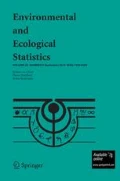Abstract
A primary objective in quantitative risk assessment is the characterization of risk which is defined to be the likelihood of an adverse effect caused by an environmental toxin or chemcial agent. In modern risk-benchmark analysis, attention centers on the “benchmark dose” at which a fixed benchmark level of risk is achieved, with a lower confidence limits on this dose being of primary interest. In practice, a range of benchmark risks may be under study, so that the individual lower confidence limits on benchmark dose must be corrected for simultaneity in order to maintain a specified overall level of confidence. For the case of quantal data, simultaneous methods have been constructed that appeal to the large sample normality of parameter estimates. The suitability of these methods for use with small sample sizes will be considered. A new bootstrap technique is proposed as an alternative to the large sample methodology. This technique is evaluated via a simulation study and examples from environmental toxicology.
Similar content being viewed by others
References
Al-Saidy OM, Piegorsch WW, West RW and Nitcheva DK (2003). Confidence bands for low-dose risk estimation with quantal response data. Biometrics 59: 1056–1062
Armitage P and Doll R (1954). The age distribution of cancer and a multi-stage theory of carcinogenesis. Brit J Cancer 8: 1–12
Bailer AJ and Smith RJ (1994). Estimating upper confidence limits for extra risk in quantal multistage models. Risk Anal 14: 1001–1010
Bowden DC and Graybill FA (1966). Confidence bands of uniform and proportional width for linear models. J Am Stat Assoc 61: 182–198
Brand KP, Catalano PJ, Hammitt JK, Rhomberg L and Evans JS (2001). Limitations to empirical extrapolation studies: the case of BMD ratios. Risk Anal 21: 625–640
Crump KS (1984). A new method for determining allowable daily intake. Fund Appl Toxicol 4: 854–871
Crump KS (1995). Calculation of benchmark doses from continuous data. Risk Anal 15: 79–89
Crump KS and Howe R (1985). A review of methods for calculating confidence limits in low dose extrapolation. In: Clayson, DB, Krewski, D and Munro, I (eds) Toxicological risk assessment, volume I: biological and statistical criteria, pp 187–203. CRC Press, Boca Raton, FL
Crump KS, Guess HA and Deal KL (1977). Confidence intervals and tests of hypotheses concerning dose response relations inferred from animal carcinogenicity data. Biometrics 33: 437–451
Faustman EM and Bartell SM (1997). Review of noncancer risk assessment: applications of benchmark dose methods. Hum Ecol Risk Assess 3: 893–920
Guess HA and Crump KS (1976). Low-dose extrapolation of data from animal carcinogenicity experiments—analysis of a new statistical technique. Math Biosci 32: 15–36
Hall P and Pittelkow YE (1990). Simultaneous bootstrap confidence bands in regression. J Stat Comput Sim 37: 99–113
Janardan KG (1995). Environmental risk assessment model for low dose extrapolation. Commun Stat-Theor M 24: 2621–2634
Kodell RL and West RW (1993). Upper confidence limits on excess risk for quantitative responses. Risk Anal 13: 177–182
Krewski D and van Ryzin J (1981). Dose response models for quantal response toxicity data. In: Csörgö, M, Dawson, DA, Rao, JNK and Saleh, AKME (eds) Statistics and related topics, pp 201–231. North-Holland, Amsterdam
Nitcheva DK, Piegorsch WW, West RW and Kodell RL (2005). Multiplicity-adjusted inferences in risk assessment: benchmark analysis with quantal response data. Biometrics 61: 277–286
Pan W, Piegorsch WW and West RW (2003). Exact one-sided simultaneous confidence bands via Uusipaikka’s method. Ann I Stat Math 55: 243–250
Piegorsch WW, Nitcheva DK and West RW (2006). Excess risk estimation under multistage model misspecification. J Stat Comput Sim 76: 423–430
Portier CJ (1994). Biostatistical issues in the design and analysis of animal carcinogenicity experiments. Environ Health Persp 102(Suppl 1): 5–8
Schlosser PM, Lilly PD, Conolly RB, Janszen DB and Kimbell JS (2003). Benchmark dose risk assessment for formaldehyde using airflow modeling and a single-compartment, DNA-protein cross-link dosimetry model to estimate human equivalent doses. Risk Anal 23: 473–487
Schulz TW and Griffin S (1999). Estimating risk assessment exposure point concentrations when the data are not normal or lognormal. Risk Anal 19: 577–584
Smith LA and Sielken RL (1988). Bootstrap bounds for safe doses in the multistage cancer dose-response model. Commun Stat-Simul C 17: 153–175
Wogan GN, Paglialunga S and Newberne PM (1974). Carcinogenic effects of low dietary levels of Aflatoxin B1 in rats. Food Cosmet Toxicol 12: 681–685
Author information
Authors and Affiliations
Corresponding author
Rights and permissions
About this article
Cite this article
West, R.W., Nitcheva, D.K. & Piegorsch, W.W. Bootstrap methods for simultaneous benchmark analysis with quantal response data. Environ Ecol Stat 16, 63–73 (2009). https://doi.org/10.1007/s10651-007-0073-5
Received:
Revised:
Published:
Issue Date:
DOI: https://doi.org/10.1007/s10651-007-0073-5




